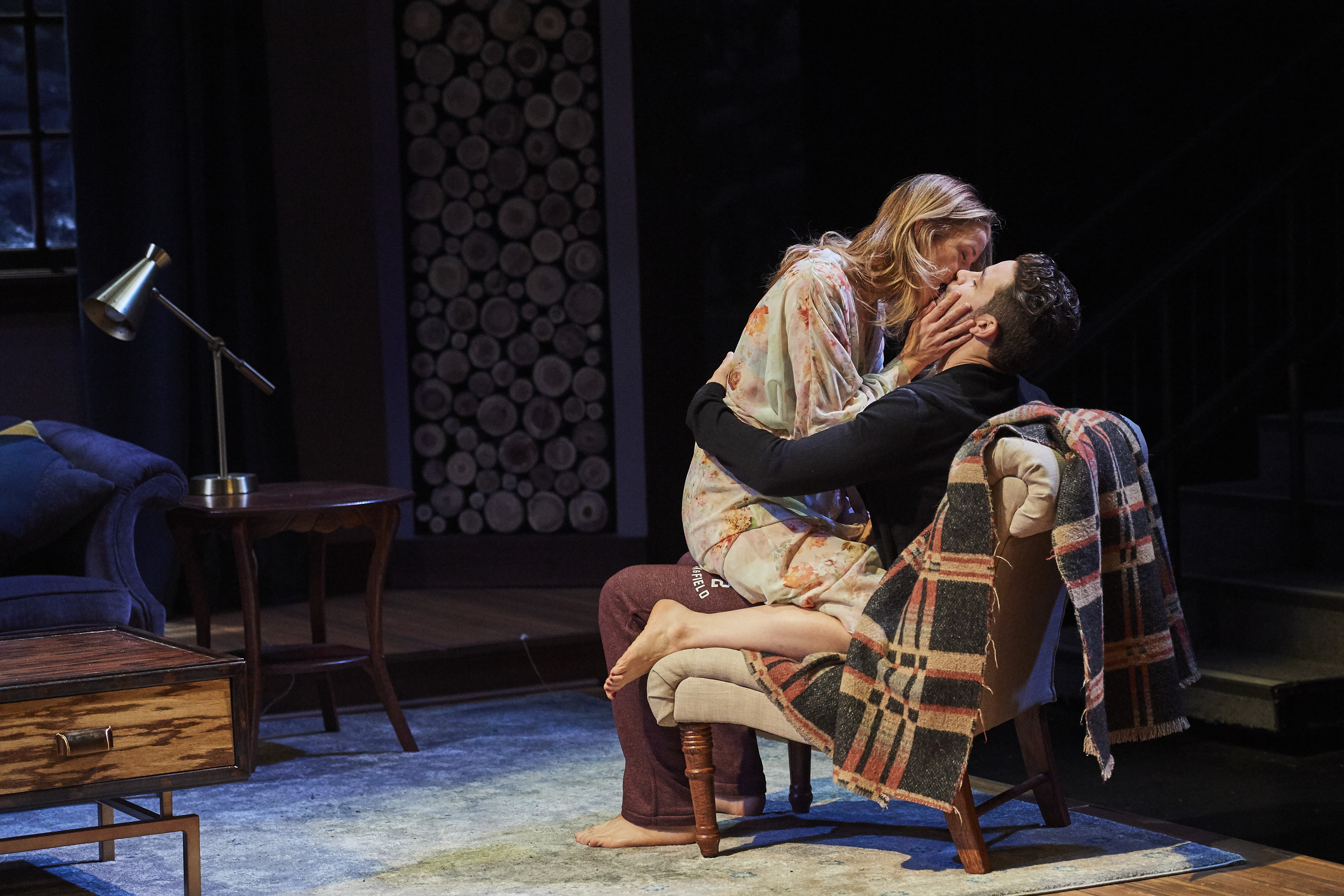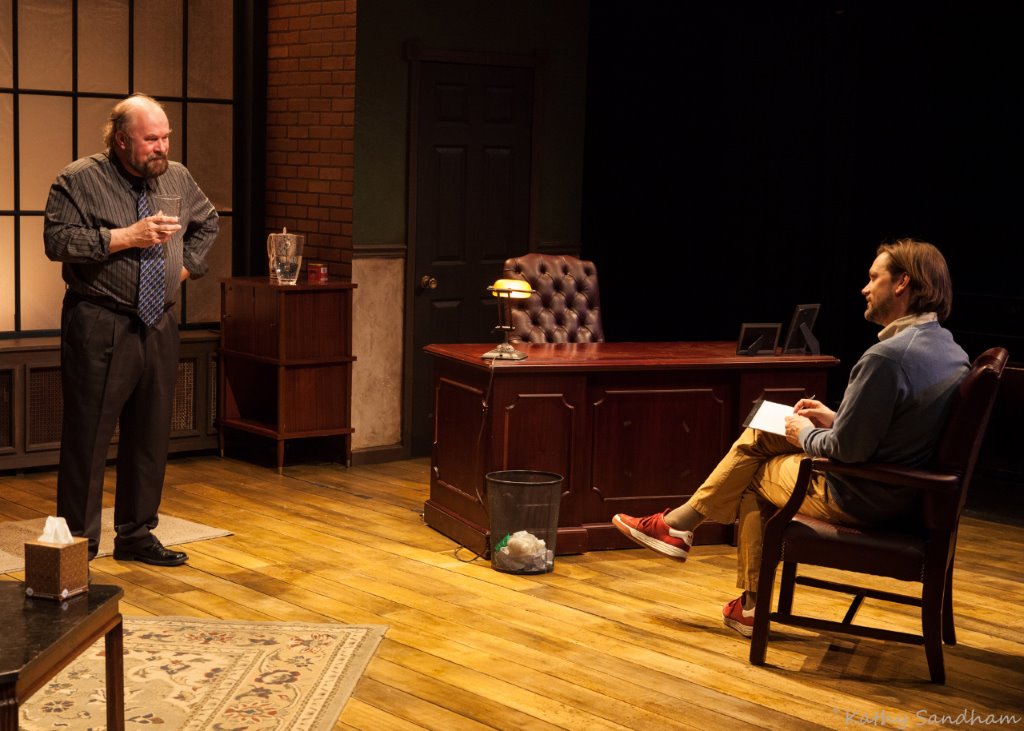The Maltz Museum’s ‘Operation Finale’ captures intensity of Nazi Adolf Eichmann’s Byzantine story
Story by Carlo Wolff
Photography by Michael C. Butz

Moshe Dayan, from left, an Israeli military leader who would become defense minister during the Six-Day War of 1967, looks on as Adolf Eichmann – viewed through the bulletproof glass booth from which he testified – listens to Moshe Landau, presiding judge at Eichmann’s trial in Jerusalem in 1961.
“Operation Finale,” the name the Mossad gave to its capture of key Nazi mechanic Adolf Eichmann, vamps on the Final Solution, the term Adolf Hitler’s regime used to prettify the extermination of the Jews the Nazis came so close to fulfilling.
“Operation Finale: The Capture & Trial of Adolf Eichmann,” on view at the Maltz Museum of Jewish Heritage in Beachwood, is an extraordinary exhibition. It engages your intellect at the start and tears your heart out by the end.
A co-production of the Mossad, the Maltz Museum and Beit Hatfutsot-The Museum of the Jewish People in Tel Aviv, “Operation Finale” presents four themes, according to Avner Avraham, a career Mossad agent who curated the Tel Aviv exhibit on which the Maltz Museum’s larger exhibit is based:
• SS Lt. Col. Eichmann’s role in the Final Solution
• The identification and capture of Eichmann in Argentina
• Preparing for and prosecuting Eichmann’s trial in Jerusalem
• The legacy of the case.

Another highlight of “Operation Finale” is a thicket of silhouette cutouts of the original Mossad team detailing each member’s specialty.
The idea is to present an installation so comprehensive that an alien visiting from outer space could tell this was the whole story, Avraham said.
The 4,000-square-foot exhibition, which features 60 original artifacts, 70 photographs and seven original films running a total of 35 minutes, is dense, informative and exciting. It starts as a thriller and ends as an epic. It gathers many pieces, several of which the Mossad has never shared, of a very large puzzle.
Unlike the more personal “Violins of Hope” exhibit at the Maltz Museum, which ended in January, “this exhibit touches on people’s emotions in a different way,” said Maltz Museum Executive Director Ellen Rudolph. The feeling here is more collective, and “Operation Finale” is more interactive.
It proceeds chronologically.
After establishing him as a key Nazi operator, “Operation Finale” tracks Eichmann to a prisoner of war camp where he spent 1945 to 1950, then follows him to Argentina, which he entered under a pseudonym, using a Red Cross passport.
Enter the Mossad, dedicated to bringing key Nazis to justice. Avraham, who also helped curate the Maltz exhibit, suggested that Mossad was as slippery as Eichmann. Actually, it was more slippery.

Mossad agent Avner Avraham spent five years curating exhibits on the capture of Adolf Eichmann in both Tel Aviv and Beachwood.
“Operation Finale” uses period photography, originals and replicas of materials including passport forging tools, license plate kits and tourist guides the 11-person Mossad team used to nail Eichmann in Buenos Aires, where he was finally identified in 1957. The father of a girl who was friends with Eichmann’s son, Nicholas, recognized the name of the elusive Nazi kingpin, alerting German law enforcement authorities and triggering the hunt.
“The Grab” would take three years, numerous identity shifts on the agents’ and Eichmann’s parts, and various automobiles and airplanes to bring down Eichmann and transport him, anesthetized, to Jerusalem. It would take close to another year and a 14-person, multilingual Mossad team to prepare for the trial, which led to Eichmann’s conviction on charges including crimes against the Jewish people and crimes against humanity. Despite protestations of innocence and a no-regret attitude, Eichmann was found guilty and hanged in 1962. His ashes were scattered on the surface of the Mediterranean Sea.
“Operation Finale” swarms with media, stressing graphics, an interactive display at the very end asking visitors to identify current hotbeds of intolerance, and, as an emotional climax, an extraordinary triptych virtually putting Eichmann on trial again.
This triptych, its centerpiece the original glass booth from the 1961 Jerusalem trial, is the display’s knockout punch. As Rudolph said, it “kind of raises you up and punches you in the stomach.”
The triptych brackets an impassive, largely expressionless Eichmann with videos of prosecutors and Holocaust survivors, many of whom told their stories for the first time there. Not only did the globally broadcast trial attest to Israel’s intelligence acumen, it also was the first time the world at large learned of the Final Solution; footage includes news clips of liberated concentration camps. This is strong stuff, and parents of children younger than 12 should take caution before exposing them to it.
“The biggest challenge in curating this exhibition, both in Beit Hatfutsot and in the Maltz Museum, was how to present this great drama of the abduction and the trial through objects/materials that the majority of them are old paper documents written in languages that not many can read,” Orit Shaham- Gover, chief curator at Beit Hatfutsot, wrote in an email from Tel Aviv.
“There are few 3-D objects in the exhibition and museums tell stories through objects. Telling this story via such ‘unattractive’ objects was definitely a challenge, and in this respect I think that” the designers in Tel Aviv and Beachwood “did a great job. Another challenge was how to portray the atrocities of the Holocaust without intimidating American visitors (Israelis are used to Holocaust images), but this I think is the challenge of every Holocaust museum.”
Shaham-Gover became involved with the Eichmann exhibit in its American version, and said she was pleased with it when she attended opening day in Beachwood Feb. 19.
Other “Operation Finale” highlights are a thicket of silhouette cutouts of the original Mossad team detailing each member’s specialty, the languages he and the lone female agent spoke, and a mini-biography; a room section lined with vintage radios, all acquired on eBay, broadcasting then-Prime Minister David Ben-Gurion’s address to Israelis about Eichmann’s conviction; and placards of photographs of Holocaust survivors, many of them local, keyed to audio that tells their stories.
The colors are largely red, black and white, and most of the photos are black and white, conjuring a pre-digital era in which intelligence agents had to hand-craft their tools and information had to be ferreted out in brick-and-mortar places. “Operation Finale” speaks eloquently of a time when the world was only actual and guilt and innocence seemed clearer than they do today.
Michael “Mickey” Goldman, a key figure in Eichmann’s prosecution, was 17 when a Gestapo train transported him and his family to an extermination camp in Belzec in southeastern Poland in 1942. Eichmann, who headed the Gestapo’s department for Jewish affairs, had lashed the boy in the ghetto nine years earlier.
In Jerusalem, Eichmann stuck to the line that he was only following orders, telling prosecutors that loyalty was the very highest value and a breach of loyalty was worse than murder. He asked for clemency toward the end of the trial.
Goldman summed up the situation succinctly, however, saying Eichmann was not a cog in the Nazi killing machine “but the machine itself.” It was Goldman who scattered Eichmann’s ashes over the waters.
In a telephone call Feb. 24 from Palm Beach Gardens, Fla., Maltz Museum founder Milton Maltz said museums in New York and Chicago, have expressed interest in “Operation Finale.”
This exhibit and “Violins of Hope,” its immediate predecessor, show “this museum is now getting national recognition for the work it’s doing,” said Maltz, adding it will also be shown in a new building at his International Spy Museum in Washington, D.C.
Maltz said he felt it was high time the Mossad was recognized, adding it took two years to negotiate with that intelligence agency and Beit Hatfutsot, the Tel Aviv museum where he first saw the Eichmann display on which his Beachwood museum. CV
On View
WHAT: Operation Finale: The Capture & Trial of Adolf Eichmann
WHEN: Through June 12
WHERE: Maltz Museum of Jewish Heritage, 2929 Richmond Road, Beachwood
TICKETS & INFO: Free to members; $12 adults; $10 students, those 60 and over; $5 ages 5-11. Call 216-593-0575 or visit maltzmuseum.org
Originally published in the Cleveland Jewish News on Feb. 24, 2016.











